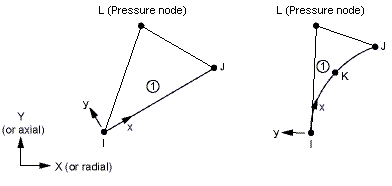
| Matrix or Vector | Shape Functions | Integration Points |
|---|---|---|
| Stiffness Matrix | Same as attached 2-D solid element | 2 or 3 |
| Load Type | Distribution |
|---|---|
| Fluid Mass Flow Rate | Fluid mass flow rate at pressure node |
| Nodal Temperature | Temperature at the pressure node |
HSFLD241 is used to model fluids that are fully enclosed by solids (containing vessels). The logic for HSFLD241 is very similar to that given for HSFLD242 - 3-D Hydrostatic Fluid, with the differences noted below:
The element thickness must be input on R command.
If KEYOPT(3) = 0, the element behaves as 2-D. The determination for plane stress or plane strain behavior is done based on the attached 2-D solid element.
If KEYOPT(3) = 1, the element behaves as axisymmetric.
The set of orthonormal vectors on the fluid surface for defining fluid volume is given as:
(13–366)
where:
n = outward normal vector (in X-Y plane) to the fluid surface enclosing the fluid volume t 1 = k = first tangent vector (normal to X-Y plane) to the fluid surface t 2 = second tangent vector (in X-Y plane) to the fluid surface Since the model stays in the X-Y plane, the variation of the first tangent vector is always zero. As a result, no geometric stiffness contributions are made from the rate of change of volume enclosed by the solid surface:
(13–367)